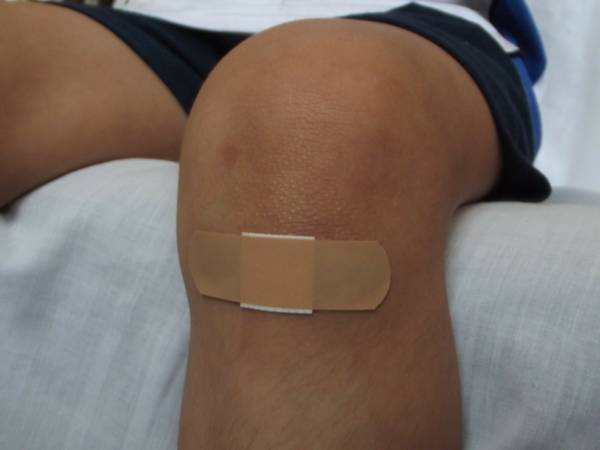How do I know if my child needs stitches?
It depends. Not every cut needs sutures, and if we jump the gun and rush to the ER, we might end up spending a lot of time and money in exchange for a simple bandaid. On the other hand (or knee or face), if we neglect a significant wound, we run the risk of infection and unnecessary scarring. So here are some things to keep in mind when your child falls on the sidewalk or runs into the corner of a piece of furniture.
Lacerations that won’t stop bleeding need to be looked at. Direct pressure over a wound, maybe with some ice, will stop most bleeding within five minutes. Use a clock, and don’t assume you can accurately estimate the passage of five minutes, especially when there’s screaming or blood or both involved. If the bleeding doesn’t stop, someone needs to have a look.
If you see “white stuff” in the wound, the cut is most likely through the full-thickness of the skin, and you’re looking at fatty tissue. No big deal, but this wound will need thorough cleansing and some kind of closure.
A laceration over a joint—elbow, finger, knee—will also need attention. There will be a lot of tension on the wound, which increases the risk of it repeatedly popping open. These take a while to heal.
Don’t take a chance with your child’s face, unless you’re dealing with a miniscule puncture wound or a superficial scratch. While keeping in mind that it’s impossible to cut the skin without a scar, we want the smallest scar possible. More often than not, this will require some kind of closure.
Let’s consider the types of closure that are available to us. The goal is to “approximate” the wound edges, bringing them together without too much tension, in order that these edges can “knit” together. We can use synthetic sutures, skin glue (Dermabond), staples, and steri-strips. Each of these are appropriate in the right setting. The key is to understand the setting.
But doctor, I don’t want my child to have stitches. Just use some skin glue.
We wish it were that simple, and painless. Skin glue has its uses, but only with wounds that are superficial and not gaping. A good rule of thumb is that “what you see is what you get.” The width of a wound in its initial state is going to be close to the width of the final scar months and years later. That’s why we want to “approximate” the wound as soon as we can. Here’s another rule of thumb: At one week of healing, scar tissue is forming in the wound, but is very weak. It takes at least sixth months for the scar to achieve its near final strength. And contrary to popular belief, a scar will never be as strong as the original, healthy skin.
So what about steri-strips? We should only use these to provide additional support in holding a wound together, never as primary closure. They can also be useful once stitches have been removed, but will only stay in place for a couple of days. Yet even that may be helpful and should be considered.
And finally, when should we consider skin staples? The answer is “not very often.” Accurate placement of staples requires proper training and experience, things that apparently are not very common. They can be used successfully on the scalp, but their placement in other areas can lead to unnecessary scarring and a “step-off” between the wound edges. The sad truth is that staples in the acute setting (i.e., the ER) are frequently used as an expedient—they are quicker to use than well-placed sutures. And absent the hands of an experienced provider, the outcome will be much less satisfactory. This is one of those times when we need to speak up and ask about other options.
Okay, so we have stitches. When can little Billy take a bath?
Another good question. Most closed wounds will “seal over” in about twenty-four hours. After that time, it’s safe to let the wound get wet but then quickly and gently dried. This is no license for an hour of soaking in the tub, but a shower should be fine. Again, pat dry right away and apply some kind of ointment. Nothing magical here, just triple-antibiotic or bacitracin.
What might be magical is what we use after the stitches come out. The general guideline here is to remove stitches on the face in five to seven days, and everywhere else in ten to fourteen. Sutures left longer than that will dig into the skin and cause scarring themselves. (We’ve seen them still in place for as long as three or four months!) Now, the magic. We want to heal the wound and minimize scarring. Once the sutures are removed, we advise parents to apply Vaseline—that’s right, simple old-fashioned Vaseline—to the wound twice a day for a week or two. A thin film is all you need, and the results are as good or better than the much-higher priced “scar reducers” you can find on-line, at your drugstore, or even by prescription.
Lacerations. They’re going to happen, so be prepared and try not to panic.
…
This is an excerpt from the new book I’m writing with pediatrician Dr. Robert Alexander. The book will address 100 questions from parents regarding their children’s health. Feel free to email us with questions: askthedox@yahoo.com


Add Comment